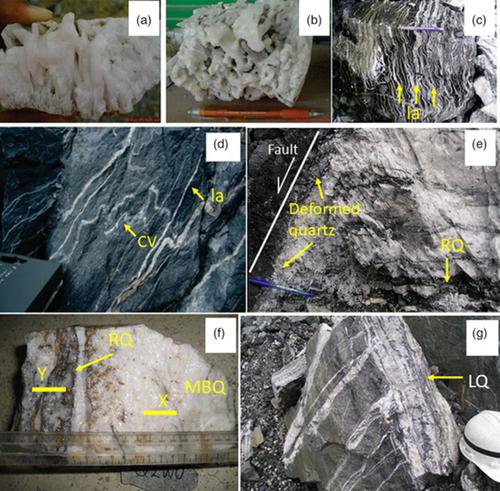当前位置:
X-MOL 学术
›
Resour. Geol.
›
论文详情
Our official English website, www.x-mol.net, welcomes your
feedback! (Note: you will need to create a separate account there.)
Texture and morphology of veins and their relationship to gold mineralization in the Penjom deposit, Malaysia
Resource Geology ( IF 1.1 ) Pub Date : 2022-02-23 , DOI: 10.1111/rge.12288 Zakaria Endut 1 , Tham Fatt Ng 2 , Jasmi Hafiz Abdul Aziz 2 , Charles Makoundi 3 , Haslikhalijah Dauad 1 , Kamar Shah Ariffin 1
Resource Geology ( IF 1.1 ) Pub Date : 2022-02-23 , DOI: 10.1111/rge.12288 Zakaria Endut 1 , Tham Fatt Ng 2 , Jasmi Hafiz Abdul Aziz 2 , Charles Makoundi 3 , Haslikhalijah Dauad 1 , Kamar Shah Ariffin 1
Affiliation

|
Penjom deposit is an orogenic gold deposit located in the Central Belt of Peninsular Malaysia. Gold mineralization is associated with various styles and textures of quartz-carbonate veins hosted within the metasedimentary as the main host rock and felsic igneous rock including minor volcanic rock. Vein textural features and morphologies have been investigated based on macroscopic and microscopic characteristics to understand the process of veins formation, and the relationship with gold mineralization. At the hand specimen scale, veins show a variety of textures that are either primary or superimposed. Primary textures are comb, massive anhedral buck quartz veins, and laminae veins or vein septa representing early vein introduction without vein modification. Extension veins that are normally concordant to maximum compressive stress direction show either a common comb texture within these veins or buck texture inside thick veins. Secondary textures are ribbon, stylolites, breccias, and late spider veinlets that overprint early veins formed during repeated structural episodes. Later stage deformation events superimposed on the existing veins texture results in intensely deformed veins. The interrelationship of structure, vein-type and texture, gold and sulfide mineralogy have been correlated to constrain the episodes of gold mineralization in the Penjom deposit. Characteristics of vein textures indicate physio-environment under confining lithostatic pressure where fluids filled the space through crack and sealing mechanism. Vein systems and gold mineralization events that have been correlated with the D2D3 (fold-fault) deformation events and inferred to be temporally related to the late-stage regional orogenic event dated Late Triassic-Early Jurassic that affected Peninsular Malaysia.
中文翻译:

马来西亚 Penjom 矿床脉的质地和形态及其与金矿化的关系
Penjom 矿床是位于马来西亚半岛中央地带的造山金矿床。金矿化与作为主要宿主岩的变沉积岩和包括次要火山岩在内的长英质火成岩中的石英碳酸盐脉的各种样式和质地有关。从宏观和微观特征研究了矿脉的纹理特征和形态,以了解矿脉的形成过程以及与金矿化的关系。在手标本尺度上,静脉显示出各种原始纹理或叠加纹理。主要纹理是梳状、块状倒角石英脉和纹层脉或脉隔,代表早期静脉引入,没有静脉修改。通常与最大压应力方向一致的延伸脉在这些脉内显示出常见的梳状纹理或在粗脉内显示出降压纹理。次要纹理是带状、柱状石、角砾岩和晚期蜘蛛纹,它们覆盖在重复结构事件中形成的早期静脉。叠加在现有静脉纹理上的后期变形事件导致强烈变形的静脉。Penjom 矿床的构造、脉型和质地、金和硫化物矿物学之间的相互关系限制了金矿化的发生。静脉纹理特征表明围岩静压下的生理环境,流体通过裂缝和密封机制填充空间。与金矿相关的脉系统和金矿化事件 次要纹理是带状、柱状石、角砾岩和晚期蜘蛛纹,它们覆盖在重复结构事件中形成的早期静脉。叠加在现有静脉纹理上的后期变形事件导致强烈变形的静脉。Penjom 矿床的构造、脉型和质地、金和硫化物矿物学之间的相互关系限制了金矿化的发生。静脉纹理特征表明围岩静压下的生理环境,流体通过裂缝和密封机制填充空间。与金矿相关的脉系统和金矿化事件 次要纹理是带状、柱状石、角砾岩和晚期蜘蛛纹,它们覆盖在重复结构事件中形成的早期静脉。叠加在现有静脉纹理上的后期变形事件导致强烈变形的静脉。Penjom 矿床的构造、脉型和质地、金和硫化物矿物学之间的相互关系限制了金矿化的发生。静脉纹理特征表明围岩静压下的生理环境,流体通过裂缝和密封机制填充空间。与金矿相关的脉系统和金矿化事件 叠加在现有静脉纹理上的后期变形事件导致强烈变形的静脉。Penjom 矿床的构造、脉型和质地、金和硫化物矿物学之间的相互关系限制了金矿化的发生。静脉纹理特征表明围岩静压下的生理环境,流体通过裂缝和密封机制填充空间。与金矿相关的脉系统和金矿化事件 叠加在现有静脉纹理上的后期变形事件导致强烈变形的静脉。Penjom 矿床的构造、脉型和质地、金和硫化物矿物学之间的相互关系限制了金矿化的发生。静脉纹理特征表明围岩静压下的生理环境,流体通过裂缝和密封机制填充空间。与金矿相关的脉系统和金矿化事件 静脉纹理特征表明围岩静压下的生理环境,流体通过裂缝和密封机制填充空间。与金矿相关的脉系统和金矿化事件 静脉纹理特征表明围岩静压下的生理环境,流体通过裂缝和密封机制填充空间。与金矿相关的脉系统和金矿化事件D 2 D 3(褶皱断层)变形事件,并推断与影响马来西亚半岛的晚三叠世-早侏罗世晚期区域造山事件在时间上相关。
更新日期:2022-02-23
中文翻译:

马来西亚 Penjom 矿床脉的质地和形态及其与金矿化的关系
Penjom 矿床是位于马来西亚半岛中央地带的造山金矿床。金矿化与作为主要宿主岩的变沉积岩和包括次要火山岩在内的长英质火成岩中的石英碳酸盐脉的各种样式和质地有关。从宏观和微观特征研究了矿脉的纹理特征和形态,以了解矿脉的形成过程以及与金矿化的关系。在手标本尺度上,静脉显示出各种原始纹理或叠加纹理。主要纹理是梳状、块状倒角石英脉和纹层脉或脉隔,代表早期静脉引入,没有静脉修改。通常与最大压应力方向一致的延伸脉在这些脉内显示出常见的梳状纹理或在粗脉内显示出降压纹理。次要纹理是带状、柱状石、角砾岩和晚期蜘蛛纹,它们覆盖在重复结构事件中形成的早期静脉。叠加在现有静脉纹理上的后期变形事件导致强烈变形的静脉。Penjom 矿床的构造、脉型和质地、金和硫化物矿物学之间的相互关系限制了金矿化的发生。静脉纹理特征表明围岩静压下的生理环境,流体通过裂缝和密封机制填充空间。与金矿相关的脉系统和金矿化事件 次要纹理是带状、柱状石、角砾岩和晚期蜘蛛纹,它们覆盖在重复结构事件中形成的早期静脉。叠加在现有静脉纹理上的后期变形事件导致强烈变形的静脉。Penjom 矿床的构造、脉型和质地、金和硫化物矿物学之间的相互关系限制了金矿化的发生。静脉纹理特征表明围岩静压下的生理环境,流体通过裂缝和密封机制填充空间。与金矿相关的脉系统和金矿化事件 次要纹理是带状、柱状石、角砾岩和晚期蜘蛛纹,它们覆盖在重复结构事件中形成的早期静脉。叠加在现有静脉纹理上的后期变形事件导致强烈变形的静脉。Penjom 矿床的构造、脉型和质地、金和硫化物矿物学之间的相互关系限制了金矿化的发生。静脉纹理特征表明围岩静压下的生理环境,流体通过裂缝和密封机制填充空间。与金矿相关的脉系统和金矿化事件 叠加在现有静脉纹理上的后期变形事件导致强烈变形的静脉。Penjom 矿床的构造、脉型和质地、金和硫化物矿物学之间的相互关系限制了金矿化的发生。静脉纹理特征表明围岩静压下的生理环境,流体通过裂缝和密封机制填充空间。与金矿相关的脉系统和金矿化事件 叠加在现有静脉纹理上的后期变形事件导致强烈变形的静脉。Penjom 矿床的构造、脉型和质地、金和硫化物矿物学之间的相互关系限制了金矿化的发生。静脉纹理特征表明围岩静压下的生理环境,流体通过裂缝和密封机制填充空间。与金矿相关的脉系统和金矿化事件 静脉纹理特征表明围岩静压下的生理环境,流体通过裂缝和密封机制填充空间。与金矿相关的脉系统和金矿化事件 静脉纹理特征表明围岩静压下的生理环境,流体通过裂缝和密封机制填充空间。与金矿相关的脉系统和金矿化事件D 2 D 3(褶皱断层)变形事件,并推断与影响马来西亚半岛的晚三叠世-早侏罗世晚期区域造山事件在时间上相关。











































 京公网安备 11010802027423号
京公网安备 11010802027423号